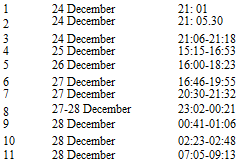THE LANDERS: A SUMMARY
Landing a cabin on the moon proved to be much more difficult than either the United States or the Soviet Union imagined. The USSR made twelve attempts, succeeding only twice. With Ranger, the Americans made three attempts, not succeeding until Surveyor 1 in June 1966. For the Russians, the main problems turned out to be the upper stage of the rocket, the translunar course and the navigation systems more than
Table 4.1. Key events in the programme of Luna 13.
No. Date Time Event
 Landing First signal
Landing First signal
First communication session Second communication session Third communication session Fourth communication session Fifth communication session Sixth communication session Seventh communication session Eighth communication session Ninth and last communication session
the actual landing phase itself. The Ye-6 landers were more sophisticated than the Ranger landers, being able to carry out a broader range of experiments and observations. They achieved the function of determining that the soil would bear a manned spacecraft and that radiation levels on the moon were acceptable. They returned detailed close-up pictures of the moonscape.
The Ye-6 design was later put to good use when the Soviet Union came to soft – land spacecraft on Mars in 1971 (Mars 3). When the American Pathfinder successfully soft-landed on Mars in 1997, it used the airbag technique developed by the Russians in the 1960s (not that this was remembered at the time). Airbags were used for the later American Mars probes Spirit and Opportunity in 2003-4. The difficulties the Americans experienced with their Mars probes also echoed some of the frustrating difficulties experienced by the Russians in the 1960s.
|
Ye-6, Ye-6M series
|
|
Luna 13 silhouettes |
Ye-6, -6M: scientific outcomes
• Density of lunar regolith similar to medium-density Earth rock, little dust, 0.8gm/cm3.
• Well able to receive a manned lunar landing vehicle.
• Radiation level of 30mrad/day, acceptable to humans.
• Moon absorbs three-quarters of cosmic radiation.
• Characterization of local landscape in two locations.
• Temperature of lunar surface, 117°C.











